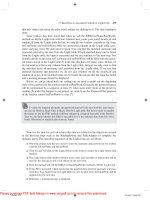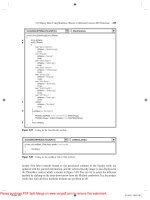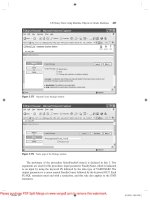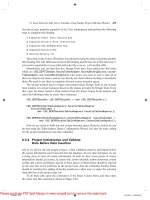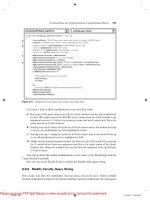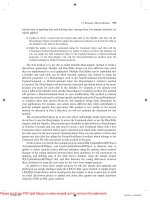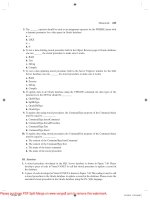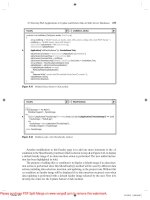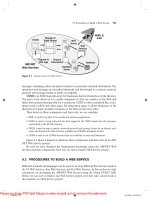Practical Database Programming With Visual C#.NET- P7
Bạn đang xem bản rút gọn của tài liệu. Xem và tải ngay bản đầy đủ của tài liệu tại đây (773.72 KB, 50 trang )
5.18 Query Data Using Runtime Objects to Microsoft Access 2007 Database
323
faculty. Five label controls bound to the associated columns in the Faculty table are
updated with the queried information, and the selected faculty image is also displayed in
the PhotoBox control, which is shown in Figure 5.89 . You can try to select the different
method by clicking on the drop - down arrow from the Method combobox. Yes, the project
works fi ne with all three methods without any problem at all!
private string ShowFaculty(string fName)
{
string strName;
switch (fName)
{
case "Black Anderson":
strName = "Anderson.jpg";
break;
case "Ying Bai":
strName = "Bai.jpg";
break;
case "Satish Bhalla":
strName = "Satish.jpg";
break;
case "Steve Johnson":
strName = "Johnson.jpg";
break;
case "Jenney King":
strName = "King.jpg";
break;
case "Alice Brown":
strName = "Brown.jpg";
break;
case "Debby Angles":
strName = "Angles.jpg";
break;
case "Jeff Henry":
strName = "Henry.jpg";
break;
default:
strName = "No Match";
break;
}
if (strName != "No Match")
{
PhotoBox.SizeMode = PictureBoxSizeMode.StretchImage;
PhotoBox.Image = System.Drawing.Image.FromFile(strName);
}
return strName;
}
A
B
C
D
E
AccessSelectRTObject.FacultyForm ShowFaculty()
Figure 5.87
Coding for the ShowFaculty method.
359
private void cmdBack_Click(object sender, EventArgs e)
{
this.Hide();
}
AccessSelectRTObject.FacultyForm cmdBack_Click()
Figure 5.88
Coding for the cmdBack button Click method.
c05.indd 323c05.indd 323 2/11/2010 2:58:31 PM2/11/2010 2:58:31 PM
Please purchase PDF Split-Merge on www.verypdf.com to remove this watermark.
324
Chapter 5 Data Selection Query with Visual C#.NET
Our next job is to do the coding for the Course form.
5.18.4 Query Data Using Runtime Objects for Course Form
Three data query methods will be used for the data query on this form: DataAdapter,
DataReader, and LINQ method. As we did for the FacultyForm, we also need to use the
OleDb data provider to perform the data query in this CourseForm. Thus, fi rst we need
to add one more namespace, System.Data.OleDb, into the namespace section on the code
window of this form. Open the code window and add
using System.Data.OleDb;
to the namespace part of this form.
Next we need to create a class - level textbox array, CourseTextBox[6], and a class
level DataSet object ds. The textbox array is used to temporarily save fi ve columns in the
Course data table, and we need this array when we retrieve and assign columns to the
associated textbox controls on the CourseForm window as the project runs. The ds
DataSet is used for the LINQ method since there is no direct relationship between the
LINQ and Access database, and we need this DataSet to perform a LINQ to DataSet
operation to do the data query (refer to Figure 5.90 ).
Now we need to do the coding for the constructor of the CourseForm to do some
initialization tasks. Enter the codes into the constructor, and your fi nished coding should
match that shown in Figure 5.90 .
Let ’ s see how this piece of code works.
A. The namespace System.Data.OleDb is added here since we need to use this OleDb Data
Provider to perform the data query in this form.
B. This coding fragment is very similar to the one we did for the Faculty form. The only dif-
ference is that the Label array has been replaced by a TextBox array since we used 5
textbox controls to display the detailed course information that is related to the selected
faculty from the Faculty Name combobox. The Course table has 7 columns, but we only
Figure 5.89
Running status of the Faculty form.
c05.indd 324c05.indd 324 2/11/2010 2:58:32 PM2/11/2010 2:58:32 PM
Please purchase PDF Split-Merge on www.verypdf.com to remove this watermark.
5.18 Query Data Using Runtime Objects to Microsoft Access 2007 Database
325
need six of them, so the size of this TextBox array is 6 and each element or each TextBox
control in this array is indexed from 0 to 5. The ds DataSet is used for the LINQ to DataSet
method.
C. All faculty names in the CSE_DEPT are added into the ComboName combobox control
and the fi rst faculty is selected as the default one.
D. Three query methods, DataAdapter, DataReader, and LINQ to DataSet, are added into the
ComboMethod combobox control, and the fi rst method is selected as the default method.
The next coding job is for the Select button. After the user selected the desired data
query method from the Method combobox and the faculty member from the Faculty
Name combobox, the Select button is used to trigger its Click method to retrieve all
courses (basically all course_id) taught by the selected faculty.
Before we can go ahead and do this coding, you need to note that we need two
queries to perform this data action in this method because there is no faculty_name
column available in the Course table, and the only available column in the Course table
is faculty_id. Therefore, we must fi rst make a query to the Faculty table to fi nd the
faculty_id that is related to the faculty name selected by the user from the Faculty Name
combobox in the Course form, and then we can make the second query to the Course
table to pickup all course_id based on the faculty_id we obtained from the fi rst query.
using System;
using System.Collections.Generic;
using System.ComponentModel;
using System.Data;
using System.Data.OleDb;
using System.Drawing;
using System.Linq;
using System.Text;
using System.Windows.Forms;
namespace AccessSelectRTObject
{
public partial class CourseForm : Form
{
private TextBox[] CourseTextBox = new TextBox[6];
DataSet ds = new DataSet();
public CourseForm()
{
InitializeComponent();
ComboName.Items.Add("Ying Bai");
ComboName.Items.Add("Satish Bhalla");
ComboName.Items.Add("Black Anderson");
ComboName.Items.Add("Steve Johnson");
ComboName.Items.Add("Jenney King");
ComboName.Items.Add("Alice Brown");
ComboName.Items.Add("Debby Angles");
ComboName.Items.Add("Jeff Henry");
ComboName.SelectedIndex = 0;
ComboMethod.Items.Add("DataAdapter Method");
ComboMethod.Items.Add("DataReader Method");
ComboMethod.Items.Add("LINQ & DataSet Method");
ComboMethod.SelectedIndex = 0;
}
A
B
C
D
AccessSelectRTObject.CourseForm CourseForm
Figure 5.90
Coding for the constructor of the CourseForm.
c05.indd 325c05.indd 325 2/11/2010 2:58:33 PM2/11/2010 2:58:33 PM
Please purchase PDF Split-Merge on www.verypdf.com to remove this watermark.
326
Chapter 5 Data Selection Query with Visual C#.NET
The queried course_id is displayed in the CourseList box, and the detailed course infor-
mation for each course can be displayed in fi ve textboxes when the user clicks on the
associated course_id from the CourseList box.
Now return to the CourseForm window by clicking on the View Designer button,
and double - click on the Select button to open its Click method and enter the codes shown
in Figure 5.91 into this method.
The coding of this part is very similar to the one we did for the Select button Click
method in the Faculty form. Let ’ s see how this piece of code works.
A. Two query strings are used for this data query. The fi rst is used to fi nd the faculty_id based
on the faculty name from the Faculty table. The second is used to retrieve all course_id
from the Course table. The course table has seven columns but we only need six of them.
There are six query items related to six columns: course_id, course, credit, classroom,
schedule, and the enrollment. The course_id column contains the course_id that will be
displayed in the CourseList box, and the other fi ve items will be displayed in fi ve textboxes
as the detailed information for selected course_id. The faculty_id is used as the criterion
to query the desired course information for the selected faculty.
B. The necessary instances and data components are also created at this part to aid with the
data query task. Two sets of objects, which include DataAdapters, Commands, and
DataTables, are declared, and one set is for the Faculty table and the other set is for the
Course table. The DataReader object is used for the data querying using the DataReader
method, and the DataRow object is used to reserve the returned row from the Faculty
table. The string variable strFacultyID is used to hold the queried faculty_id from the
Faculty table.
C. Then the fi rst Command object, accCmdFaculty, is initialized by assigning it with the
Connection instance, Command type, and the query string. The dynamic parameter
Param1 is obtained from the Faculty Name combobox in which the faculty name will be
selected by the user as the project runs.
D. The completed Command object accCmdFaculty is assigned to the SelectCommand prop-
erty of the FacultyDataAdapter, which is ready to make query by using the Fill() method.
E. The Fill() method is executed to fi ll the faculty data table named accFacultyTable, and it
is used to fi nd the faculty_id that is matched to the selected faculty name from the
ComboName in the CourseForm from the Faculty table.
F. By checking the Count property, we can confi rm whether this Fill is successful or not.
If the value of this property is greater than 0, which means that at least one row has
been selected and fi lled into the Faculty table, the returned fi rst row or the only row,
accFacultyTable.Rows[0], is assigned to the DataRow object rowFaculty. Then the fi rst
column in that row, rowFaculty[0], which is the matched faculty_id, is converted to string
and saved to the strFacultyID variable that will be used later.
G. An error message will be displayed if this Fill() has failed.
H. Next the course Command object accCmdCourse is initialized and the dynamic parameter
@Param2 is replaced by the real parameter faculty_id obtained from the fi rst query we did
above.
I. As we did for the Faculty form, the user can make a choice among three query methods:
DataAdapter, DataReader, and LINQ to DataSet. If the user selects the DataAdapter
method, the built command object in step H will be assigned to the SelectCommand prop-
erty of the CourseDataAdapter and the Fill() method of the DataAdapter will be executed
to fi ll the Course table, accCourseTable.
c05.indd 326c05.indd 326 2/11/2010 2:58:33 PM2/11/2010 2:58:33 PM
Please purchase PDF Split-Merge on www.verypdf.com to remove this watermark.
5.18 Query Data Using Runtime Objects to Microsoft Access 2007 Database
327
private void cmdSelect_Click(object sender, EventArgs e)
{
string strFaculty = "SELECT faculty_id FROM Faculty WHERE faculty_name = @Param1";
string strCourse = "SELECT course_id, course, credit, classroom, schedule, enrollment, faculty_id FROM Course ";
strCourse += "WHERE faculty_id = @Param2";
OleDbDataAdapter CourseDataAdapter = new OleDbDataAdapter();
OleDbDataAdapter FacultyDataAdapter = new OleDbDataAdapter();
OleDbCommand accCmdFaculty = new OleDbCommand();
OleDbCommand accCmdCourse = new OleDbCommand();
DataTable accCourseTable = new DataTable();
DataTable accFacultyTable = new DataTable();
LogInForm logForm = new LogInForm();
logForm = logForm.getLogInForm();
OleDbDataReader accDataReader;
string strFacultyID = string.Empty;
DataRow rowFaculty;
accCmdFaculty.Connection = logForm.accConnection;
accCmdFaculty.CommandType = CommandType.Text;
accCmdFaculty.CommandText = strFaculty;
accCmdFaculty.Parameters.Add("@Param1", OleDbType.Char).Value = ComboName.Text;
FacultyDataAdapter.SelectCommand = accCmdFaculty;
FacultyDataAdapter.Fill(accFacultyTable);
if (accFacultyTable.Rows.Count > 0)
{ rowFaculty = accFacultyTable.Rows[0]; strFacultyID = rowFaculty[0].ToString(); }
Else
{ MessageBox.Show("No matched faculty_id found!"); }
accCmdCourse.Connection = logForm.accConnection;
accCmdCourse.CommandType = CommandType.Text;
accCmdCourse.CommandText = strCourse;
accCmdCourse.Parameters.Add("@Param2", OleDbType.Char).Value = strFacultyID;
if (ComboMethod.Text == "DataAdapter Method")
{
CourseDataAdapter.SelectCommand = accCmdCourse;
CourseDataAdapter.Fill(accCourseTable);
if (accCourseTable.Rows.Count > 0) { FillCourseTable(accCourseTable); }
else { MessageBox.S
how("No matched course found!"); }
accFacultyTable.Dispose(); accCourseTable.Dispose(); CourseDataAdapter.Dispose();
}
else if (ComboMethod.Text == "DataReader Method")
{
accDataReader = accCmdCourse.ExecuteReader();
if (accDataReader.HasRows == true) { FillCourseReader(accDataReader); }
else { MessageBox.Show("No matched course found!"); }
accDataReader.Close(); accDataReader.Dispose();
}
else //LINQ to DataSet Method is selected
{
CourseList.Items.Clear();
CourseDataAdapter.SelectCommand = accCmdCourse;
CourseDataAdapter.Fill(ds, "Course");
var courseinfo = (from ci in ds.Tables["Course"].AsEnumerable()
where ci.Field<string>("faculty_id") == (string)strFacultyID
select ci);
foreach (var cRow in courseinfo)
CourseList.Items.Add(cRow.Field<string>("course_id"));
ds.Clear();
}
accCmdFaculty.Dispose();
accCmdCourse.Dispose();
CourseList.SelectedIndex = 0;
}
A
B
C
D
E
F
G
H
I
J
K
L
M
N
O
P
Q
R
S
T
U
V
W
AccessSelectRTObject.CourseForm cmdSelect_Click()
Figure 5.91
Coding for the cmdSelect button Click method.
c05.indd 327c05.indd 327 2/11/2010 2:58:33 PM2/11/2010 2:58:33 PM
Please purchase PDF Split-Merge on www.verypdf.com to remove this watermark.
328
Chapter 5 Data Selection Query with Visual C#.NET
J. If this fi ll is successful, the Count property of the Course table should be greater than 0,
which means that the table is fi lled by at least one row. The user - defi ned method
FillCourseTable() will be called with the fi lled table as the argument to fi ll the CourseList
box control with the course_id on the Course form.
K. Otherwise, if this Count is equal to 0, which means that no row or record has been fi lled
into the Course table. An error message will be displayed for this situation.
L. Some necessary cleaning jobs are performed to release all objects we used for this data
query.
M. If the user selected the DataReader method, the ExecuteReader() method is called to
perform a reading - only operation to the Course table.
N. If the HasRows property of the DataReader is True, which means that the DataReader
did receive some data, the user - defi ned method FillCourseReader() is executed with the
DataReader as the argument to fi ll the CourseList box control with the course_id on the
Course form window.
O. An error message will be displayed if the HasRows property is false.
P. The DataReader object is released after it is used up.
Q. If the user selects the LINQ to DataSet method, fi rst we need to clean up the CourseList
control to make it ready to be fi lled with course_id.
R. Then we need to build a new DataSet object by executing the Fill() method to fi ll the
Course table in that new DataSet object since we need this DataSet to perform a LINQ
to DataSet query.
S. A typical LINQ query structure is created and executed to retrieve back all related
course_id for the selected faculty_id. The courseinfo is a Visual C# 2008 implicitly typed
local variable with a data type var. The Visual C# 2008 will be able to automatically convert
this var to any suitable data type; in this case, it is a collection when it sees it. An iteration
variable ci is used to iterate over the result of this query from the Course table. Then a
similar SQL SELECT statement is executed with the WHERE clause. The fi rst key point
for this structure is the operator AsEnumerable(). Since different database systems use
different collections and query operators, those collections must be converted to a type of
IEnumerable< T > in order to use the LINQ technique because all data operations in LINQ
use a Standard Query Operator method that can perform complex data queries on an
IEnumerable< T > sequence. A compiling error would be encountered without this opera-
tor. The second key point is that you have to use the explicit cast (string) to convert the
strFacultyID to the string object and then assign it to the fi eld of faculty_id as the criterion
for this query.
T. The foreach loop is utilized to pick up each column from the selected data row cRow,
which is obtained from the courseinfo we get from the LINQ query. Then, add each
column to the CourseList in the CourseForm window to display them. Since we are using
a nontyped DataSet, we must indicate each column clearly with the fi eld < string > and the
column ’ s name as the position for each of them.
U. This DataSet ’ s cleaning is very important, and a lot of sequences of duplicated course_id
would be added into the CourseList without this cleaning. The reason is that the new
course_id columns will be attached to the DataSet each time when the Fill() method is
executed if the DataSet were not cleaned.
V. Two Command objects are released before we can exit this method.
W. This coding is very important, and it is used to select the fi rst course_id as the default
one from the CourseList box, and this coding can be used to trigger the CourseList_
c05.indd 328c05.indd 328 2/11/2010 2:58:33 PM2/11/2010 2:58:33 PM
Please purchase PDF Split-Merge on www.verypdf.com to remove this watermark.
5.18 Query Data Using Runtime Objects to Microsoft Access 2007 Database
329
SelectedIndexChanged() method to display detailed information for the selected
course_id in fi ve textboxes. Without this default course_id selected, no detailed course
information can be displayed as the Course List_SelectedIndexChanged() method is exe-
cuted at the fi rst time.
Now let ’ s take a look at the codes of two user - defi ned methods, FillCourseTable()
and FillCourseReader(). These two methods are used to fi ll the CourseList box control
on the Course form by using the queried data obtained either from the DataAdapter or
from the DataReader. The detailed codes for these two methods are shown in Figure
5.92 .
Let ’ s see how this piece of code works.
A. Before we can fi ll the CourseList box, a cleaning job is needed. This cleaning is very
important and necessary, otherwise multiple duplicated course_id would be displayed in
this listbox if you forget to clean it up fi rst.
B. A foreach loop is used to scan all rows of the fi lled Course table. Recall that we queried
six columns from the Course table in the database and fi lled them to this Course table in
the DataSet starting with the fi rst column that is course_id (refer to query string strCourse
defi ned in the cmdSelect button Click method; see Figure 5.91 ). Now we need to pick up
the fi rst column — course_id (column index = 0) — for each returned row from the Course
table. Then add each course_id into the CourseList control to display them by using the
Add() method.
C. For the FillCourseReader() method, a local string variable strCourse is created, and this
variable can be considered as an intermediate variable that is used to temporarily hold
the queried column from the Course table.
D. We also need to clean up the CourseList box before it can be fi lled.
E. A while loop is utilized to retrieve each fi rst column ’ s data [GetString(0)] whose column
index is 0 and the data value is the course_id. The queried data is fi rst assigned to the
intermediate variable strCourse, and then it is added into the CourseList box by using the
Add() method.
private void FillCourseTable(DataTable CourseTable)
{
CourseList.Items.Clear();
foreach (DataRow row in CourseTable.Rows)
{
CourseList.Items.Add(row[0]); //the 1st column is course_id - strCourse
}
}
private void FillCourseReader(OleDbDataReader CourseReader)
{
string strCourse = string.Empty;
CourseList.Items.Clear();
while (CourseReader.Read())
{
strCourse = CourseReader.GetString(0); //the 1st column is course_id
CourseList.Items.Add(strCourse);
}
}
A
B
C
D
E
AccessSelectRTObject.CourseForm FillCourseTable()
Figure 5.92
Coding for two user - defi ned methods.
c05.indd 329c05.indd 329 2/11/2010 2:58:33 PM2/11/2010 2:58:33 PM
Please purchase PDF Split-Merge on www.verypdf.com to remove this watermark.
330
Chapter 5 Data Selection Query with Visual C#.NET
Next we need to take care of the coding for the CourseList_SelectedIndexChanged()
method. The functionality of this method is to display the detailed course information
related to the selected course_id from the CourseList box, which includes the course
name, classroom, schedule, credit, and enrollment in 5 textbox controls on the Course
form. This method can be triggered as the user clicked on a course_id from the CourseList
box.
Open the Course form window by clicking on the View Designer button from the
Solution Explorer window, and then double - click on the Courselist box to open its
CourseList_SelectedIndexChanged() method. Enter the codes shown in Figure 5.93
into this method. The code segment in this part is very similar to the one we did for the
cmdSelect button Click method.
Let ’ s see how this piece of code works.
A. The query string is defi ned with 6 data columns that contain the detailed course informa-
tion. Note that the fi rst column is the course name with a column index of 0, and the cri-
terion for the WHERE clause is course_id. This is because we want to retrieve all course
information related to the selected course_id and display those pieces of information in
the 5 textbox controls.
B. The data components and objects used in this method are declared and created here, which
include CourseDataAdapter, Command, DataTable, DataReader, and an instance of
the LogInForm class. The purpose of creating this new instance is to get the Connection
object from the LogInForm object since we created our database connection object in that
class.
C. The Command object is initialized with the Connection object, CommandType, and
CommandText properties.
D. The dynamic parameter @Param1 is replaced by the real parameter, CourseList.
SelectedItem, which will be selected by the user from the CourseList box as the project
runs.
E. If the user selects the DataAdapter method, the built command object is assigned to the
SelectCommand property of the CourseDataAdapter, and the Fill() method is executed
with the Course table as the argument to fi ll the Course table.
F. If this fi ll is successful, which can be detected by checking the Count property of
the DataTable, the queried data has been stored in the Course table. Next the
FillCourseTextBox() method is executed with the DataTable as the argument to fi ll fi ve
textbox controls in the Course form window.
G. Otherwise an error message will be displayed if this fi ll has failed.
H. A cleaning job is performed to release objects used in this part, which include the DataTable
and the CourseDataAdapter.
I. If the user selects the DataReader method, the ExecuteReader() method is executed to
perform a read - only operation to retrieve the information related to the selected course_id
from the CourseList box.
J. If this read - only operation is successful, the HasRows property of the DataReader will be
True, the method FillCourseReaderTextBox() is called to fi ll fi ve textbox controls on the
Course form window.
K. An error message will be displayed if this read - only operation has failed.
L. A cleaning job is performed to release the DataReader object used in this data query.
c05.indd 330c05.indd 330 2/11/2010 2:58:34 PM2/11/2010 2:58:34 PM
Please purchase PDF Split-Merge on www.verypdf.com to remove this watermark.
5.18 Query Data Using Runtime Objects to Microsoft Access 2007 Database
331
private void CourseList_SelectedIndexChanged(object sender, EventArgs e)
{
string cmdString = "SELECT course, credit, classroom, schedule, enrollment, course_id FROM Course ";
cmdString += "WHERE course_id = @Param1";
OleDbDataAdapter CourseDataAdapter = new OleDbDataAdapter();
OleDbCommand accCommand = new OleDbCommand();
DataTable accDataTable = new DataTable();
OleDbDataReader accDataReader;
LogInForm logForm = new LogInForm();
logForm = logForm.getLogInForm();
accCommand.Connection = logForm.accConnection;
accCommand.CommandType = CommandType.Text;
accCommand.CommandText = cmdString;
accCommand.Parameters.Add("@Param1", OleDbType.Char).Value = CourseList.SelectedItem;
if (ComboMethod.Text == "DataAdapter Method")
{
CourseDataAdapter.SelectCommand = accCommand;
CourseDataAdapter.Fill(accDataTable);
if (accDataTable.Rows.Count > 0)
FillCourseTextBox(accDataTable);
else
MessageBox.Show("No matched course information found!");
accDataTable.Dispose();
CourseDataAdapter.Dispose();
}
else if (ComboMethod.Text == "DataReader Method")
{
accDataReader = accCommand.ExecuteReader();
if (accDataReader.HasRows == true)
FillCourseReaderTextBox(accDataReader);
else
MessageBox.Show("No matched course information found!");
accDataReader.Close();
accDataReader.Dispose();
}
else //LINQ & DataSet Methos is selected
{
DataSet dc = new DataSet();
CourseDataAdapter.SelectCommand = accCommand;
CourseDataAdapter.Fill(dc, "Course");
var cinfo = (from c in
dc.Tables["Course
"].AsEnumerable()
where c.Field<string>("course_id") == (string)CourseList.SelectedItem
select c);
foreach (var crow in cinfo)
{
txtName.Text = crow.Field<string>("course");
txtSchedule.Text = crow.Field<string>("schedule");
txtClassRoom.Text = crow.Field<string>("classroom");
txtCredits.Text = crow.Field<int>("credit").ToString();
txtEnroll.Text = crow.Field<int>("enrollment").ToString();
}
dc.Clear();
}
accCommand.Dispose();
}
A
B
C
D
E
F
G
H
J
K
L
M
N
O
P
Q
AccessSelectRTObject.CourseForm CourseList_SelectedIndexChanged()
I
Figure 5.93
Coding for the CourseList SelectedIndexChanged method.
c05.indd 331c05.indd 331 2/11/2010 2:58:34 PM2/11/2010 2:58:34 PM
Please purchase PDF Split-Merge on www.verypdf.com to remove this watermark.
332
Chapter 5 Data Selection Query with Visual C#.NET
M. If the user selects the LINQ to DataSet method, fi rst we need to create a new DataSet
object dc and build it by executing the Fill() method. The SelectCommand property of the
CourseDataAdapter should have been initialized with the accCommand object we built in
step C .
N. A typical LINQ query structure is created and executed to retrieve back the detailed
course information related to course_id. The cinfo is a Visual C# 2008 implicitly typed
local variable with a data type var. The Visual C# 2008 will be able to automatically convert
this var to any suitable data type, in this case, it is a collection, when it sees it. An iteration
variable c is used to iterate over the result of this query from the Course table. Then a
similar SQL SELECT statement is executed with the WHERE clause. The fi rst key point
for this structure is the operator AsEnumerable(). Since different database systems use
different collections and query operators, those collections must be converted to a type of
IEnumerable< T > in order to use the LINQ technique because all data operations in LINQ
use a Standard Query Operator method that can perform complex data queries on an
IEnumerable< T > sequence. A compiling error would be encountered without this opera-
tor. The second key point is that you have to use the explicit cast (string) to convert the
CourseList.SelectedItem to the string object and then assign it to the fi eld of course_id as
the criterion for this query.
O. The foreach loop is utilized to pick up each column from the selected data row crow, which
is obtained from the cinfo we get from the LINQ query. Then, assign each column to the
associated textbox control in the CourseForm window to display them. Since we are using
a nontyped DataSet, we must indicate each column clearly with the fi eld < string > and the
column ’ s name as the position for each of them.
P. After this data query is done, we need to clean up the DataSet object. This cleaning job
is very important and necessary. Otherwise the multiple duplicated course_id will be
attached to the DataSet and displayed in the CourseList box each time when you click the
Select button to query the course_id using this method if you forget this cleaning code.
Q. Finally the Command object is disposed of.
The codes for three user - defi ned methods, FillCourseTextBox(), MapCourseTable(),
and FillCourseReaderTextBox(), are shown in Figure 5.94 .
Let ’ s see how this piece of code works.
A. A local integer variable pos1 is created, and this variable will work as the loop counter for
the foreach loop to retrieve each column from the Course table and assign each of them
to the associated textbox control in the Course form to display them.
B. The class - level object array and textbox array are initialized here. Here six textbox objects
are initialized, and they can be mapped to fi ve textbox controls in the Course form window
(note that the course_id does not have a matched textbox control in the CourseForm since
we do not need it). We use these fi ve textbox objects to display the detailed course infor-
mation for the selected course_id from the CourseList box later.
C. The MapCourseTable() method is executed to set up a one - to - one mapping relationship
between each textbox control on the Course form window and each queried column in the
query. This step is necessary since the distribution order of fi ve textbox controls on the
CourseForm is different with the column order in the query string cmdString defi ned in
the CourseList_SelectedIndexChabnged() method.
D. A double foreach loop is utilized to retrieve all columns and all rows from the Course
DataTable; that is, the outer loop is only executed one time since we only query one record
(one row) based on the selected course_id from the Course data table. The inner loop is
c05.indd 332c05.indd 332 2/11/2010 2:58:34 PM2/11/2010 2:58:34 PM
Please purchase PDF Split-Merge on www.verypdf.com to remove this watermark.
5.18 Query Data Using Runtime Objects to Microsoft Access 2007 Database
333
executed six times to pick up six pieces of course - related information that contains the
course name, classroom, credit, schedule, enrollment, and course_id. Then the retrieved
information is assigned to each textbox control in the textbox array, which will be displayed
in that textbox control in the CourseForm later. The course_id is an exception since we
do not need to display it in this application.
E. For the method MapCourseTable(), it assigns each textbox control to the matched partner
in the textbox array to set up a correct relationship between them.
F. In the FillCourseReaderTextBox() method, a loop counter intIndex is fi rst created, and it
is used for the loop of initialization of the textbox object array and the loop of retrieving
data from the DataReader later.
G. This loop is used to initialize the textbox object array.
H. The MapCourseTable() method is executed to set up a correct relationship between the
textbox controls and the textbox array.
I. A while and a for loop are used to pick up all fi ve piece of course - related information from
the DataReader one by one. The Read() method is used as the while loop condition. A
private void FillCourseTextBox(DataTable CourseTable)
{
int pos1 = 0;
for (int pos2 = 0; pos2 <= 5; pos2++) //Initialize the object array
CourseTextBox[pos2] = new TextBox();
MapCourseTable(CourseTextBox);
foreach (DataRow row in CourseTable.Rows)
{
foreach (DataColumn column in CourseTable.Columns)
{
CourseTextBox[pos1].Text = row[column].ToString();
pos1++;
}
}
}
private void MapCourseTable(Object[] fCourse)
{
fCourse[0] = txtName; //The order must be identical with
fCourse[1] = txtCredits; //the real order in the query string -
fCourse[2] = txtClassRoom; //cmdString
fCourse[3] = txtSchedule;
fCourse[4] = txtEnroll;
}
private void FillCourseReaderTextBox(OleDbDataReader CourseReader)
{
int intIndex = 0;
for (intIndex = 0; intIndex <= 5; intIndex++) //Initialize the object array
CourseTextBox[intIndex] = new TextBox();
MapCourseTable(CourseTextBox);
while (CourseReader.Read())
{
for (intIndex = 0; intIndex <= CourseReader.FieldCount - 1; intIndex++)
CourseTextBox[intIndex].Text = CourseReader.GetValue(intIndex).ToString();
}
}
A
B
C
D
E
F
G
H
I
AccessSelectRTObject.CourseForm FillCourseTextBox()
Figure 5.94
Coding for three methods.
c05.indd 333c05.indd 333 2/11/2010 2:58:34 PM2/11/2010 2:58:34 PM
Please purchase PDF Split-Merge on www.verypdf.com to remove this watermark.
334
Chapter 5 Data Selection Query with Visual C#.NET
returned True means that a valid data is read out from the DataReader, and a returned
False means that no valid data has been read out from the DataReader; in other words,
no more data is available and all data has been read out. The for loop uses the FieldCount - 1
as the termination condition since the index of the fi rst data fi eld is 0, not 1, in the
DataReader object. Each read - out data is converted to a string and assigned to the associ-
ated textbox control in the textbox object array.
The last coding is for the cmdBack button Click method. This coding is very simple
and it is shown in Figure 5.95 . The CourseForm window will disappear from the screen
when this button is clicked on by the user.
Now let ’ s test our project by clicking on the Start button. Enter the username and
password as we did before, and select the Course Information from the Selection form
window to open the Course form window, which is shown in Figure 5.96 .
Select any method you want by clicking on the drop - down arrow from the Method
combobox, and then select your desired faculty from the Faculty Name combobox. Click
on the Select button, and all courses represented by the related course_id taught by that
faculty will be displayed in the CourseList box, which is shown in Figure 5.96 . Then select
and click a desired course_id from the CourseList box. The detailed course information
related to that selected course_id will be displayed in fi ve textbox controls. (Isn ’ t it so
funny!)
private void cmdBack_Click(object sender, EventArgs e)
{
this.Hide();
}
AccessSelectRTObject.CourseForm cmdBack_Click()
Figure 5.95
Coding for the cmdBack button Click method.
Figure 5.96
Running status of the Course form window.
c05.indd 334c05.indd 334 2/11/2010 2:58:34 PM2/11/2010 2:58:34 PM
Please purchase PDF Split-Merge on www.verypdf.com to remove this watermark.
5.18 Query Data Using Runtime Objects to Microsoft Access 2007 Database
335
5.18.5 Query Data Using Runtime Objects for Student Form
Basically, the coding for this Student form is similar to the coding we did for the Course
form in the last section. The functionality of this Student form is to allow users to review
the detailed information for each student in the CSE DEPT, which includes the student
ID, major, GPA, school year, total credits the student earned, and courses the student
took. The courses taken by the student are displayed in a CourseList box, and all other
information is displayed in fi ve textboxes as one clicks on the Select button.
The coding for this form is a little special since two data tables are utilized for this
form: Student and StudentCourse. The fi rst table contains the student ’ s general infor-
mation and the second one contains all courses taken by the student. Therefore two
DataAdapters are needed for this application. Also two different data queries are
needed to query data from two tables. The fi rst one is used to retrieve the student ’ s
general information from the Student table, and the second is to pick up all course
information (course_id) for the courses taken by the student from the StudentCourse
table.
In order to save space, only two query methods — DataAdapter and LINQ to DataSet
methods — are provided in this section. For the DataReader query method, we like to
leave it as homework to the students.
The coding job is divided into two parts with two major methods: the constructor of
the Student class and the cmdSelect_Click method. The fi rst one is used to initialize the
Student form and display all students ’ names on the combobox control, which can be
selected by the user to review the related information for the selected student. The
second one is to execute the data queries to pick up the selected student ’ s general and
course information and display them in the associated textbox controls and the ListBox
control.
5.18.5.1 Coding for Constructor of Student Form
As we did before for the LogIn, Faculty, and Course forms, add the OleDb namespace,
System.Data.OleDb, into this code window since we need to use it in this data query.
The coding for this constructor is shown in Figure 5.97 . Let ’ s take a look at this piece
of code to see how it works.
A. A new DataSet instance and a TextBox array StudentTextBox[] is created here. The
DataSet instance is used for the LINQ to DataSet method, and the textbox object array
is used to set up a mapping relationship between the 6 textboxes in the Student form and
6 query columns in the query string strStudent, student_id, gpa, credits, major, schoolYear,
and email. The reason we defi ned the size of this array as 7 is that we need the seventh
column, student_name, when we query data using the LINQ to DataSet method later.
B. Five students ’ names are added into the ComboName combobox. As the project runs, the
user can select any student by clicking the associated name to review the detailed informa-
tion for the selected student in 6 textboxes and all courses taken by that student in the
CourseList box.
C. Two querying methods, DataAdapter and LINQ to DataSet, are added into the
ComboMethod combobox to allow users to select either one to perform the data query
as the project runs. The fi rst item in both comboboxes is selected as the default item by
setting the SelectedIndex property to 0.
c05.indd 335c05.indd 335 2/11/2010 2:58:36 PM2/11/2010 2:58:36 PM
Please purchase PDF Split-Merge on www.verypdf.com to remove this watermark.
336
Chapter 5 Data Selection Query with Visual C#.NET
5.18.5.2 Coding for Student Select Button Click Method
As the project runs, the user can select a student ’ s name from the student name
combobox and click on the Select button to acquire the detailed information for the
selected student. The detailed information for the selected student is retrieved from the
Student table in the CSE_DEPT database and displayed in six textboxes. Also all courses
that are represented by the course_id and taken by the selected student are retrieved
from the StudentCourse table and displayed in the CourseList listbox. So this method
needs to perform two queries from two different tables.
The coding for this method is shown in Figure 5.98 . Let ’ s take a close look at this
piece of code.
A. The query string for the Student table is declared fi rst and the string contains seven
columns in the Student data table, which are student_id, gpa, credits, major, schoolYear,
email, and student_name. The criterion for this query is the student name stored in the
student combobox. It looks like a contradiction exists in this string: Why do we need to
query student_name that is the last column with a known student_name as the criterion?
The answer is that the LINQ to DataSet method needs this column to call the Standard
Query Operators to perform the data query, and we will show this situation later. The
second query string is for the StudentCourse table. The queried columns are course_id
and student_id, and the query criterion is the student_id. Similarly, the repeated query for
the column student_id is for the requirement of the LINQ to DataSet method.
B. All data objects are created here, which include the Student and the StudentCourse
DataAdapters, Commands, and DataTables. The string variable strName is used to hold
the returned name of the student ’ s image fi le from the calling of the function FindName().
C. The FindName() function is called to get and display the appropriate student ’ s image based
on the student name. If no matched image can be found, an error message is displayed.
D. The method BuildCommand() is called to build the Student Command object with the
Connection object and the student query string as the arguments. You will fi nd that the
data type of the fi rst argument, accCmdStudent, is a reference type (ref), which is equiva-
public partial class StudentForm : Form
{
DataSet ds = new DataSet();
private TextBox[] StudentTextBox = new TextBox[7]; //We query 7 columns from the Student table
public StudentForm()
{
InitializeComponent();
ComboName.Items.Add("Erica Johnson");
ComboName.Items.Add("Ashly Jade");
ComboName.Items.Add("Holes Smith");
ComboName.Items.Add("Andrew Woods");
ComboName.Items.Add("Blue Valley");
ComboName.SelectedIndex = 0;
ComboMethod.Items.Add("DataAdapter Method");
ComboMethod.Items.Add("LINQ & DataSet Method");
ComboMethod.SelectedIndex = 0;
A
B
C
AccessSelectRTObject.StudentForm StudentForm()
}
........
Figure 5.97
Coding for the constructor of the Student Form.
c05.indd 336c05.indd 336 2/11/2010 2:58:36 PM2/11/2010 2:58:36 PM
Please purchase PDF Split-Merge on www.verypdf.com to remove this watermark.
5.18 Query Data Using Runtime Objects to Microsoft Access 2007 Database
337
lent to a memory address or a constant pointer variable in C++. The reason is that when
this method is done, the built command object will still be stored in that memory address
and we can use it directly. This is very similar to using a returned object from the calling
of this method.
E. The dynamic parameter @Param1 in the fi rst query string is replaced by the real student
name obtained from the student name combobox, and the completed Command
private void cmdSelect_Click(object sender, EventArgs e)
{
string strStudent = "SELECT student_id, gpa, credits, major, schoolYear, email, student_name FROM Student ";
strStudent += "WHERE student_name = @Param1";
string strStudentCourse = "SELECT course_id, student_id FROM StudentCourse WHERE student_id = @Param2";
OleDbDataAdapter StudentDataAdapter = new OleDbDataAdapter();
OleDbDataAdapter StudentCourseDataAdapter = new OleDbDataAdapter();
OleDbCommand accCmdStudent = new OleDbCommand();
OleDbCommand accCmdStudentCourse = new OleDbCommand();
DataTable accStudentTable = new DataTable();
DataTable accStudentCourseTable = new DataTable();
string strName = string.Empty;
strName = FindName(ComboName.Text);
if (strName == "No Match")
MessageBox.Show("No Matched Student’s Image Found!");
BuildCommand(ref accCmdStudent, strStudent);
accCmdStudent.Parameters.Add("@Param1", OleDbType.Char).Value = ComboName.Text;
StudentDataAdapter.SelectCommand = accCmdStudent;
if (ComboMethod.Text == "DataAdapter Method")
{
StudentDataAdapter.Fill(accStudentTable);
if (accStudentTable.Rows.Count > 0)
FillStudentTextBox(accStudentTable);
else
MessageBox.Show("No matched student found!");
BuildCommand(ref accCmdStudentCourse, strStudentCourse);
accCmdStudentCourse.Parameters.Add("@Param2", OleDbType.Char).Value = txtID.Text;
StudentCourseDataAdapter.SelectCommand = accCmdStudentCourse;
StudentCourseDataAdapter.Fill(accStudentCourseTable);
if (accStudentCourseTable.Rows.Count > 0)
FillCourseList(accStudentCourseTable);
else
MessageBox.Show("No matched course_id found!");
}
else //LINQ to DataSet Method
{
StudentDataAdapter.Fill(ds, "Student");
LINQStudent(ds);
BuildCommand(ref accCmdStudentCourse, strStudentCourse);
accCmdStudentCourse.Parameters.Add("@Param2", OleDbType.Char).Value = txtID.Text;
StudentCourseDataAdapter.SelectCommand = accCmdStudentCourse;
StudentCourseDataAdapter.Fill(ds, "StudentCourse");
LINQStudentCourse(ds);
ds.Clear();
}
accStudentTable.Dispose();
accStudentCourseTable.Dispose();
StudentDataAdapter.Dispose();
StudentCourseDataAdapter.Dispose();
accCmdStudent.Dispose();
accCmdStudentCourse.Dispose();
}
A
B
C
D
E
F
G
H
I
J
K
L
M
N
O
P
Q
AccessSelectRTObject.StudentForm cmdSelect_Click()
Figure 5.98
Coding for the Student Select button Click method.
c05.indd 337c05.indd 337 2/11/2010 2:58:36 PM2/11/2010 2:58:36 PM
Please purchase PDF Split-Merge on www.verypdf.com to remove this watermark.
338
Chapter 5 Data Selection Query with Visual C#.NET
object accCmdStudent is assigned to the SelectCommand property of the Student
DataAdapter.
F. If the DataAdapter method is selected, the Fill() method is called to fi ll the Student
table.
G. By checking the Count property, we can inspect whether this fi ll is successful or not. If this
property is greater than 0, which means that at least one row has been fi lled into the
Student data table and the fi ll is successful, the user - defi ned method FillStudentTextBox()
is called with the fi lled Student table as the argument to fi ll six textboxes in the
Student form with the detailed student ’ s information such as student_id, gpa, credits,
major, schoolYear, and email.
H. Otherwise, an error message is displayed.
I. To make the second query to the StudentCourse table to fi nd all courses taken by the
selected student, the BuildCommand() is called again to initialize and build the
StudentCourse Command object. The dynamic parameter @Param2 is replaced by
the real student_id, which was obtained from the fi rst query and stored in the textbox
txtID. The completed StudentCourse Command object, accCmdStudentCourse, is assigned
to the SelectCommand property of the StudentCourse DataAdapter.
J. The Fill() method is called to fi ll the StudentCourse data table.
K. If the Count property of the DataRow object in the StudentCourse table is greater than
0, which means that the fi ll is successful, another user - defi ned method FillCourseList() is
executed to fi ll all courses (that is, course_id) stored in the fi lled StudentCourse table into
the CourseList box in the Student form.
L. Otherwise if the Count property is 0, which means that this fi ll has failed, an error message
is displayed.
M. If the LINQ to DataSet method is selected, a new instance of the DataSet ds is created by
executing the Fill() method since we need this DataSet to perform the data query using
this method. Then a user - defi ned method, LINQStudent(), is called to perform this data
query and retrieve back all queried information for the selected student, and display it in
six textboxes in the Student form.
N. Next we need to perform the second query to the StudentCourse table to retrieve back all
courses taken by the selected student. First we need to build the Command object, and
then we need to create another instance of the DataSet class using the Fill() method.
O. Another user - defi ned method LINQStudentCourse() is called to retrieve back all courses
(that is, course_id) from the StudentCourse table and add them into the CourseList listbox
in the Student form.
P. The new created instance of the DataSet is cleaned up. This step is very important and
necessary for this data query. Otherwise a lot of duplicated courses will be added into the
DataSet object and displayed in the CourseList listbox each time you click on the Select
button if this cleaning is not done. Those duplications can be effectively avoided by clean-
ing the DataSet object each time when this method is executed.
Q. Finally another cleaning job is performed to release all objects used in this method.
Now let ’ s continue to fi nish the coding for all user - defi ned methods, and these
methods are:
• FindName()
• BuildCommand()
c05.indd 338c05.indd 338 2/11/2010 2:58:37 PM2/11/2010 2:58:37 PM
Please purchase PDF Split-Merge on www.verypdf.com to remove this watermark.
5.18 Query Data Using Runtime Objects to Microsoft Access 2007 Database
339
• FillStudentTextBox()
• MapStudentTextBox()
• FillCourseList()
• LINQStudent()
• LINQStudentCourse()
First let ’ s handle the coding for the FindName() method. This method is similar to
the one we developed in the Faculty form, and the coding for this method is shown in
Figure 5.99 .
A switch case structure is used to select the desired student ’ s image fi le based on the
input student ’ s name, and the selected student ’ s image is displayed in a PictureBox in the
Student form using the FromFile() system method. Note the location in which the student
image fi les are located. You can save those image fi les in any folder on your computer
or a server, but you must provide the full name for the selected image and assign it to
the strName variable to be returned. The so - called full name includes the machine name,
driver name, and folder name as well as the image fi le name. An easy way to save these
image fi les is to save them in the folder in which your Visual C# project executable fi le
is located. For instance, in this application our Visual C# project executable fi le is located
in the folder C:\Chapter 5\MSAccessSelectRTObject\bin\Debug. When save all student ’ s
private string FindName(string sName)
{
string strName;
switch (sName)
{
case "Erica Johnson":
strName = "Erica.jpg";
break;
case "Ashly Jade":
strName = "Ashly.jpg";
break;
case "Holes Smith":
strName = "Holes.jpg";
break;
case "Andrew Woods":
strName = "Andrew.jpg";
break;
case "Blue Valley":
strName = "Blue.jpg";
break;
default:
strName = "No Match";
break;
}
if (strName != "No Match")
{
PhotoBox.SizeMode = PictureBoxSizeMode.StretchImage;
PhotoBox.Image = System.Drawing.Image.FromFile(strName);
}
return strName;
}
AccessSelectRTObject.StudentForm FindName()
Figure 5.99
Coding for the FindName method.
c05.indd 339c05.indd 339 2/11/2010 2:58:37 PM2/11/2010 2:58:37 PM
Please purchase PDF Split-Merge on www.verypdf.com to remove this watermark.
340
Chapter 5 Data Selection Query with Visual C#.NET
image fi les in this folder, you don ’ t need to provide the so - called full name for those
images, and you only need to provide the image fi le ’ s name and assign it to the variable
strName. That is much easier! The codes for the BuildCommand() method are shown in
Figure 5.100 .
The coding is straightforward with no tricks. The different properties of the Command
class such as the Connection string, Command type, and Command text are assigned to
the Command object. Note that the data type of the fi rst argument — cmdObj — is a refer-
ence (ref), as we mentioned above in step D . A reference in Visual C# 2008 is equivalent
to a memory address or a pointer in C++, and the argument cmdObj is called passing by
reference. When an argument is passing in this mode, the object cmdObj will work as
both an input and an output argument, and they will be stored at the same address when
this method is completed. We can use this built cmdObj as a returned object even if it is
an argument without needing to return this cmdObj object from this method.
For some other user - defi ned methods used in this form, such as FillStudentTextBox(),
FillCourseList(), and MapStudentTextBox(), the coding for them is similar to that we
developed in the Course form. For your convenience, we list them here again with some
simple explanations. The coding for the FillStudentTextBox() method is shown in Figure
5.101 .
private void BuildCommand(ref OleDbCommand cmdObj, string cmdString)
{
LogInForm logForm = new LogInForm();
logForm = logForm.getLogInForm();
cmdObj.Connection = logForm.accConnection;
cmdObj.CommandType = CommandType.Text;
cmdObj.CommandText = cmdString;
}
AccessSelectRTObject.StudentForm
BuildCommand()
Figure 5.100
The BuildCommand method.
private void FillStudentTextBox(DataTable StudentTable)
{
int pos1 =0;
for (int pos2 = 0; pos2 <= 6; pos2++) //Initialize the textbox array
StudentTextBox[pos2] = new TextBox();
MapStudentTextBox(StudentTextBox);
foreach (DataRow row in StudentTable.Rows)
{
foreach (DataColumn column in StudentTable.Columns)
{
StudentTextBox[pos1].Text = row[column].ToString();
pos1++;
}
}
}
AccessSelectRTObject.StudentForm FillStudentTextBox()
Figure 5.101
Coding for the FillStudentTextBox method.
c05.indd 340c05.indd 340 2/11/2010 2:58:37 PM2/11/2010 2:58:37 PM
Please purchase PDF Split-Merge on www.verypdf.com to remove this watermark.
5.18 Query Data Using Runtime Objects to Microsoft Access 2007 Database
341
The function of this piece of code is to fi ll six textboxes in the Student form with six
column ’ s data obtained from the Student table, such as student_id, gpa, credits, major,
schoolYear, and email, which is the fi rst query we discussed above. The StudentTextBox
array is initialized fi rst, and then the method MapStudentTextBox() is called to set up a
correct relationship between the StudentTextBox array and six textboxes in the Student
form. A nested foreach loop is executed to pick up each column from the queried rows.
Exactly only one row data that matches the selected student name is obtained from the
Student table; therefore, the outer loop is only executed once. The reason for using a
double loop is that both the DataRow and the DataColumn are classes, and in order to
pick up data from any DataTable, one must use the row and column objects as the index
to access each row or column of DataTable instead of using an integer. The local integer
variable pos1 works as an index for the StudentTextBox array.
The coding for the MapStudentTextBox() method is shown in Figure 5.102 . The
purpose of this coding is to set up a correct relationship between each textbox control in
the StudentTextBox array and each column data in our fi rst query string — strStudent.
Each textbox control in the StudentTextBox array is related to an associated textbox
control in the Student form such as student_id, gpa, credits, major, schoolYear, and email.
Since the distribution order of those textboxes in the StudentTextBox array may be dif-
ferent with the order of those column data in our fi rst query, a correct order relationship
can be set up by executing this method.
The coding for the FillCourseList() method is shown in Figure 5.103 . The function
of this method is to fi ll the CourseList box with all courses taken by the selected student,
and those queried courses are stored in the StudentCourse table, which are obtained by
executing the second query to the StudentCourse table based on the student_id. In order
private void MapStudentTextBox(Object[] sTextBox)
{
}
sTextBox[0] = txtID; //The order must be identical with the
sTextBox[1] = txtGPA; //order in the query string - strStudent
sTextBox[2] = txtCredits;
sTextBox[3] = txtMajor;
sTextBox[4] = txtSchoolYear;
sTextBox[5] = txtEmail;
AccessSelectRTObject.StudentForm MapStudentTextBox()
Figure 5.102
Coding for the MapStudentTextBox method.
private void FillCourseList(DataTable StudentCourseTable)
{
CourseList.Items.Clear();
foreach (DataRow row in StudentCourseTable.Rows)
{
CourseList.Items.Add(row[0]); //the 1st column is course_id - strStudentCourse
}
}
AccessSelectRTObject.StudentForm FillCourseList()
Figure 5.103
Coding for the FillCourseList method.
c05.indd 341c05.indd 341 2/11/2010 2:58:37 PM2/11/2010 2:58:37 PM
Please purchase PDF Split-Merge on www.verypdf.com to remove this watermark.
342
Chapter 5 Data Selection Query with Visual C#.NET
to pick up each course_id from the StudentCourse table, a DataRow object is created
fi rst, and it can be used to hold each row or record queried from the StudentCourse table.
After the CourseList box is cleared, a foreach loop is executed to pick up each row from
the StudentCourse table, and the fi rst column, which is row(0), is course_id added into
the CourseList box by executing the Add method.
Now let ’ s handle the coding for two methods related to the LINQ to DataSet method.
First let ’ s take care of the method LINQStudent(). The coding for this method is shown
in Figure 5.104 .
Let ’ s take a closer look at this piece of code to see how it works.
A. A typical LINQ query structure is created and executed to retrieve back the detailed
student information related to the student_name. The studentinfo is a Visual C# 2008
implicitly typed local variable with a data type var. The Visual C# 2008 will automatically
convert this var to any suitable data type; in this case, it is a collection. An iteration vari-
able si is used to iterate over the result of this query from the Student table. Then a similar
SQL SELECT statement is executed with the WHERE clause. The fi rst key point for this
structure is the operator AsEnumerable(). Since different database systems use different
collections and query operators, those collections must be converted to a type of
IEnumerable < T > in order to use the LINQ technique because all data operations in LINQ
use a Standard Query Operator method that can perform complex data queries on an
IEnumerable < T > sequence. A compiling error would be encountered without this opera-
tor. The second key point is that you have to use the explicit cast (string) to convert the
ComboName. Text to the string object and then assign it to the fi eld of student_name as
the criterion for this query.
B. The foreach loop is utilized to pick up each column from the selected data row sRow,
which is obtained from the studentinfo we get from the LINQ query. Then, assign each
column to the associated textbox control in the StudentForm window to display them.
Since we are using a nontyped DataSet, we must indicate each column clearly with the
fi eld < string > and the column ’ s name as the position for each of them.
The coding for the LINQStudentCourse() method is shown in Figure 5.105 . Let ’ s see
how this piece of code works.
private void LINQStudent(DataSet dSet)
{
var studentinfo = (from si in dSet.Tables["Student"].AsEnumerable()
where si.Field<string>("student_name") == (string)ComboName.Text
select si);
foreach (var sRow in studentinfo)
{
this.txtID.Text = sRow.Field<string>("student_id");
this.txtSchoolYear.Text = sRow.Field<string>("schoolYear");
this.txtGPA.Text = sRow.Field<string>("gpa");
this.txtCredits.Text = sRow.Field<int>("credits").ToString();
this.txtMajor.Text = sRow.Field<string>("major");
this.txtEmail.Text = sRow.Field<string>("email");
}
}
A
B
AccessSelectRTObject.StudentForm LINQStudent()
Figure 5.104
Coding for the LINQStudent method.
c05.indd 342c05.indd 342 2/11/2010 2:58:38 PM2/11/2010 2:58:38 PM
Please purchase PDF Split-Merge on www.verypdf.com to remove this watermark.
